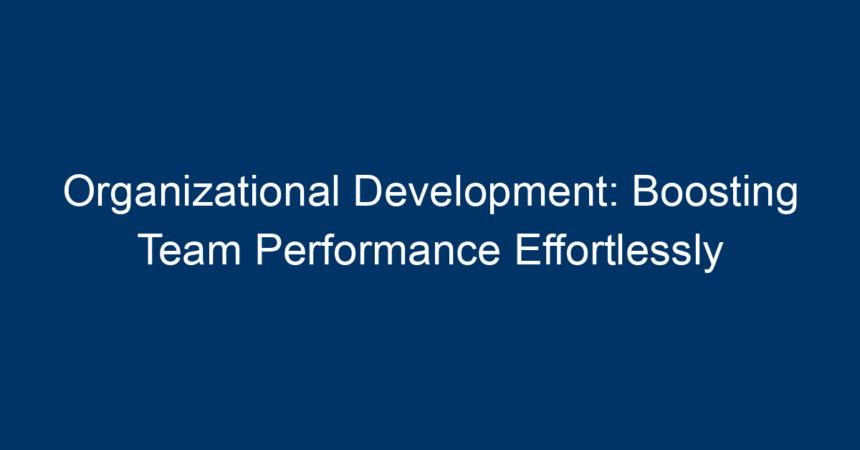In today’s rapidly evolving business landscape, the importance of organizational development (OD) cannot be overstated. In an era where adaptability and innovation are crucial for success, organizations are increasingly recognizing the need for effective team performance strategies. This article delves deep into how organizational development can effortlessly boost team performance, enhance collaboration, and foster a thriving workplace culture. With practical insights and strategies, we aim to provide a comprehensive guide for integrating organizational development into your team dynamics.
What is Organizational Development?
Organizational development is a systematic approach aimed at increasing an organization’s effectiveness and health through planned change. It encompasses a wide array of activities, including training and development, team-building exercises, and strategic planning. OD focuses on improving communication, fostering positive relationships, and building a culture of continuous improvement. By prioritizing these elements, organizations can achieve enhanced performance and long-term sustainability.
The Importance of Organizational Development
-
Enhanced Team Cohesion: One of the primary benefits of organizational development is improved team relationships. When teams work better together, productivity naturally increases.
-
Increased Efficiency: Through strategic OD interventions, organizations can streamline operations, eliminating redundancies and inefficiencies.
-
Employee Engagement: A focus on team performance and development fosters a sense of belonging and engagement among employees, leading to higher retention rates.
- Adaptability to Change: In a world where change is the only constant, organizations that invest in OD are better equipped to respond swiftly to market shifts and internal challenges.
Key Elements of Effective Organizational Development
1. Assessment
Before any organizational development initiative can begin, a thorough assessment of the current state of the organization is crucial. This includes evaluating team dynamics, communication patterns, and performance metrics. Gathering qualitative and quantitative data through surveys, interviews, and performance reviews can provide insights into areas that need improvement.
2. Goal Setting
After identifying specific challenges, the next step is to set clear, attainable goals. These goals should align with the overall mission and vision of the organization. Using the SMART criteria (Specific, Measurable, Achievable, Relevant, Time-bound) can help ensure that the goals are structured effectively.
3. Strategy Development
Once goals are set, the focus shifts to developing strategies to achieve these objectives. This may involve designing training programs, workshops, or team-building activities tailored to the unique challenges identified. Adequate resources, including time and budget, should be allocated to execute these strategies successfully.
4. Implementation
Implementation is where the plans come to life. Ensuring that all team members are engaged and committed to the process is crucial. Clear communication regarding the objectives and expected outcomes will help align team efforts. Leaders play a pivotal role during this stage by acting as change champions.
5. Evaluation
Post-implementation, it is essential to evaluate the outcomes of the organizational development initiatives. Using feedback mechanisms such as surveys and performance metrics can help gauge success. This evaluation stage is critical for understanding the impact of the initiatives on team performance and overall organizational effectiveness.
Strategies for Boosting Team Performance through Organizational Development
1. Foster a Culture of Feedback
Feedback is a powerful tool for improvement. Encouraging an open feedback culture allows team members to share insights, recognize each other’s strengths, and identify areas for growth. Regular feedback sessions can help maintain momentum and keep everyone aligned with organizational goals.
2. Invest in Training and Development
Continuous learning is a cornerstone of organizational development. Offering training programs that focus on both hard and soft skills can significantly enhance team performance. Consider options like workshops, e-learning modules, and mentorship programs to develop employees’ capabilities.
3. Embrace Diversity and Inclusion
Diversity in teams leads to varied perspectives, fostering creativity and innovation. Embracing and promoting diversity and inclusion within teams can lead to better problem-solving and increased engagement. Ensure that all voices are heard and valued in team discussions and decision-making processes.
4. Implement Team-Building Activities
Team-building exercises can break down silos and promote collaboration among team members. Activities that encourage interaction and team cohesion—whether through in-person retreats or virtual workshops—can have a significant impact on team performance.
5. Leverage Technology
Incorporating technology into organizational development can streamline processes and facilitate collaboration. Tools like project management software, communication platforms, and performance tracking systems can enhance team efficiency and foster a culture of transparency.
The Role of Leadership in Organizational Development
Effective leadership is vital in driving organizational development initiatives. Leaders must embody the change they wish to see and inspire their teams to embrace new philosophies. Here’s how leaders can contribute to successful OD:
-
Set the Vision: Clear communication of the organization’s vision and goals helps align team efforts and motivate employees.
-
Encourage Participation: Engaging team members in decision-making processes fosters a sense of ownership and accountability.
-
Model Desired Behaviors: Leaders should demonstrate the behaviors they wish to promote, such as openness, collaboration, and a commitment to continuous learning.
- Recognize Achievements: Celebrating both individual and team successes reinforces a positive organizational culture and motivates employees to strive for excellence.
Actionable Insights for Successful Organizational Development
-
Develop a Clear Plan: Map out a clear, structured approach to organizational development, ensuring all team members understand their roles and responsibilities.
-
Prioritize Communication: Open and transparent communication is key to successful implementation. Keep lines of communication open at all times.
-
Cultivate a Learning Mindset: Encourage team members to adopt a growth mindset. Challenges should be seen as opportunities for learning and development.
-
Be Flexible: Organizational needs can change rapidly. Be prepared to adapt strategies and goals based on ongoing assessments and feedback.
- Collect Data Consistently: Regularly collect data and seek feedback to measure the impact of your organizational development initiatives.
Conclusion
In conclusion, organizational development plays a crucial role in boosting team performance. By focusing on assessment, strategic planning, implementation, and evaluation, organizations can foster a thriving workplace culture characterized by collaboration and continuous improvement. Implementing actionable insights, investing in team development, and embracing technology can create an environment where teams are empowered to perform at their best. As your organization embarks on its OD journey, remember that the key to success lies in striving for improvement and remaining adaptable to change. With the right strategies in place, enhancing team performance can indeed be an effortless endeavor.




